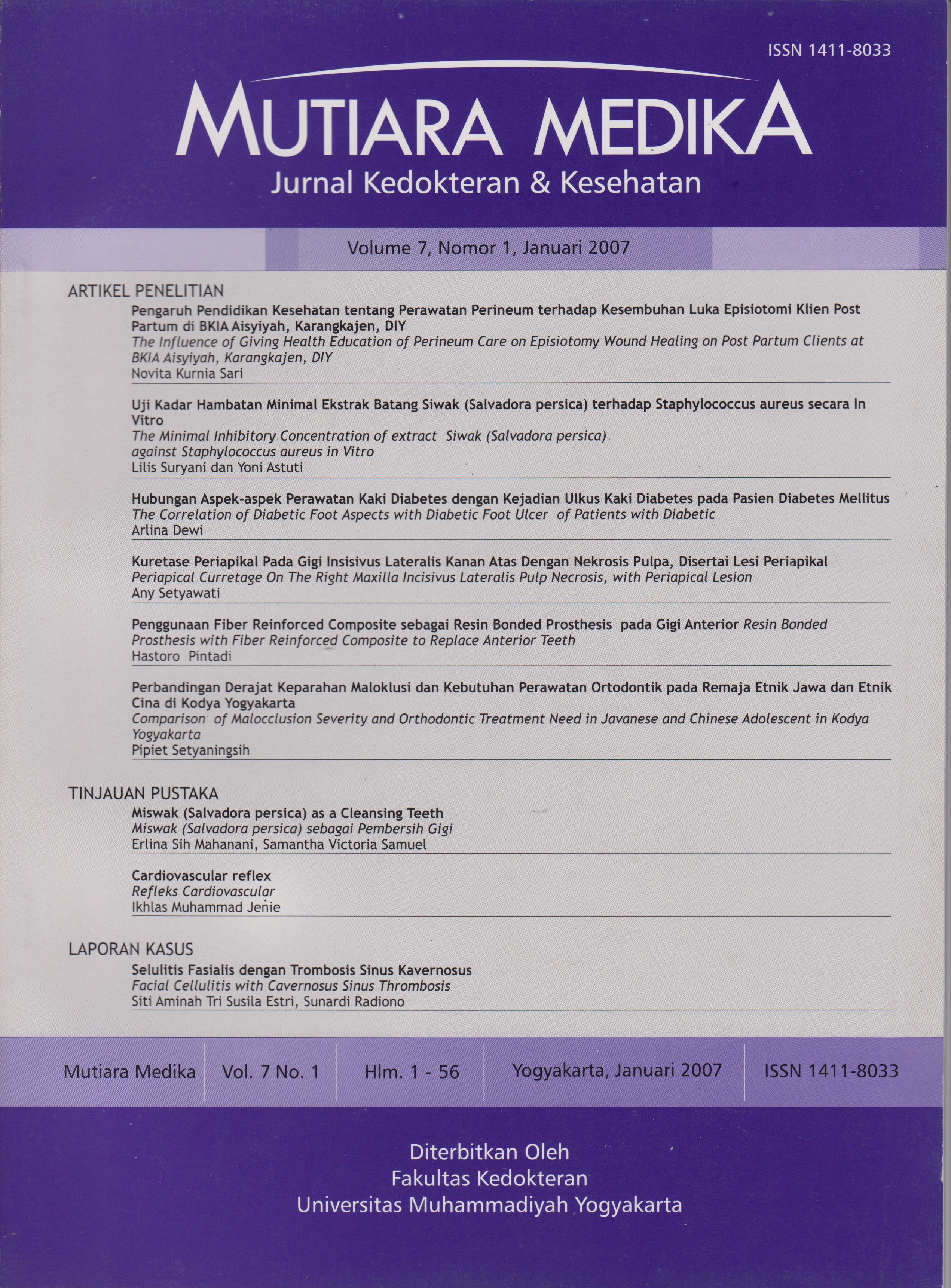Pengaruh Pendidikan Kesehatan tentang Perawatan Perineum terhadap Kesembuhan Luka Episiotomi Klien Post Partum di BKIA Aisyiyah, Karangkajen, DIY
DOI:
https://doi.org/10.18196/mmjkk.v7i1.1689Keywords:
pendidikan kesehatan, perawatan perineum, episiotomi, post partum, health education, perineum care, episiotomyAbstract
Infection incidental rate which is caused by episiotomy is still high. Based on preface study, the high level of infection is caused by lack of treatment. Lack of treatment is further triggered by lack of knowledge about episiotomy care. One of interventions which can be done is by giving health education on perineum care. This is an experimental research with the static group comparison design. The design uses 30 respondents of post partum client at BKIA Aisyiyah, Karangkajen, DIY, analyzed by Chi-Square statistical analytic. The result of this research shows that episiotomy wound healing is not influenced by providing health education on perineum care, with the value of significant level: 0.05. This study concludes that giving health education on perineum care does not give significant influence on episiotomy wound care.
Angka kejadian infeksi akibat tindakan episiotomi masih tinggi. Berdasarkan studi pendahuluan, angka infeksi masih tinggi dikarenakan kurangnya perawatan. Kurangnya perawatan dimungkinkan karena kurangnya pengetahuan tentang cara merawat luka episiotomi. Salah satu intervensi yang bisa dilakukan adalah dengan memberikan pendidikan tentang perawatan perineum. Penelitian ini merupakan penelitian eksperimen dengan desain perbandingan kelompok statis. Penelitian ini menggunakan 30 responden klien post partum di BKIA Aisyiyah, Karangkajen, DIY, dianalisis dengan menggunakan Chi-Square. Secara deskriptif hasil penelitian ini menunjukkan bahwa pendidikan kesehatan tentang perawatan perineum tidak berpengaruh terhadap kesembuhan luka episiotomi, dengan tingkat signifikansi 0,05.
References
Manuaba, Gde Ida Bagus. (1999). Operasi Kebidanan Kandungan dan Keluarga Berencana. Jakarta.
http://www.who.int/reproductive-health/ publications/abstract/maternalmortality/ 1995
Wignosastro, Hanifa. (1994). Ilmu Bedah Kebidanan. Yayasan Bina Prawirohardjo.
Brunner, and Suddarth. (2001). Buku Ajar Keperawatan Medikal Bedah. Jakarta: EGC
Reeder, Sharon J. (1997). Maternity Nursing: Family, Newborn, and Women Health Care. Philadelphia: Lippincot.
Rankin, Sally H., et al. (1996). Patient Education: Issues, Principles, Practice. Philadelphia: Lippincot-Raven Publisher.
Doak, Cecilia Conrath. (1996). Teaching Patient with Low Lateracy Skill. Philadelphia: JB. Lippincot Company.
Chesnut, Mary Ann, RN. (1997). Maternal-Newborn Home Care Manual. Philadelphia: JB. Lippincot Company.
Pilliteri, Adele. (1999). Maternal and Child Health Nursing. Philadelphia: JB. Lippincot Company.
Downloads
Published
Issue
Section
License
Copyright
Authors retain copyright and grant Mutiara Medika: Jurnal Kedokteran dan Kesehatan (MMJKK) the right of first publication with the work simultaneously licensed under an Attribution 4.0 International (CC BY 4.0) that allows others to remix, adapt and build upon the work with an acknowledgment of the work's authorship and of the initial publication in Mutiara Medika: Jurnal Kedokteran dan Kesehatan (MMJKK).
Authors are permitted to copy and redistribute the journal's published version of the work (e.g., post it to an institutional repository or publish it in a book), with an acknowledgment of its initial publication in Mutiara Medika: Jurnal Kedokteran dan Kesehatan (MMJKK).
License
Articles published in the Mutiara Medika: Jurnal Kedokteran dan Kesehatan (MMJKK) are licensed under an Attribution 4.0 International (CC BY 4.0) license. You are free to:
- Share — copy and redistribute the material in any medium or format.
- Adapt — remix, transform, and build upon the material for any purpose, even commercially.
This license is acceptable for Free Cultural Works. The licensor cannot revoke these freedoms as long as you follow the license terms. Under the following terms:
Attribution — You must give appropriate credit, provide a link to the license, and indicate if changes were made. You may do so in any reasonable manner, but not in any way that suggests the licensor endorses you or your use.
- No additional restrictions — You may not apply legal terms or technological measures that legally restrict others from doing anything the license permits.






